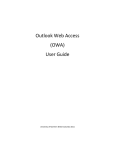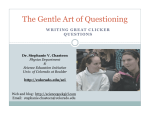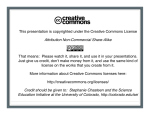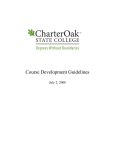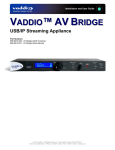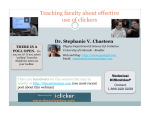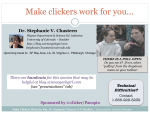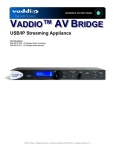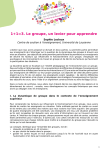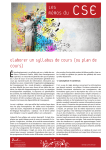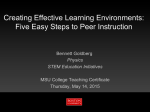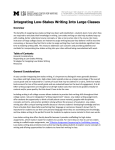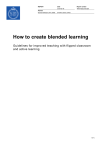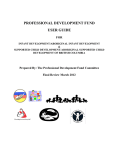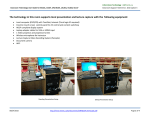Download Make clickers work for you
Transcript
Make clickers work for you... DR. STEPHANIE V. CHASTEEN Physics Department & Science Ed. Initiative University of Colorado – Boulder http://blog.sciencegeekgirl.com [email protected] Upcoming travel to: SF Bay Area, LA, W. Virginia U., Pittsburgh, Chicago! There are handouts for this session that may be helpful at blog.sciencegeekgirl.com (see “presentations” tab) Sponsored by i>clicker/Panopto Anatomy of Peer Instruction 2 Ask Question (Maybe vote) …Lecture… Class Discussion Peer Discussion Vote * See also: Peer Instruction, A User’s Manual. E. Mazur. CUʼs Science Education Initiative Resources on Clickers and Instruction CUʼs Science Education Initiative (SEI) is a 5-year $5M investment by the University of Colorado to catalyze and support significant, sustainable improvements in undergraduate science education. The SEI funds departments to take a four-step, scientific approach to undergraduate education, by establishing what students should learn, measuring what students are actually learning, use instructional approaches guided by research on learning, and disseminate and adopt what works. Clicker Resource Page http://STEMclickers.colorado.edu Set of online resources on using clickers and peer instruction, including clicker question banks, literature references, workshop materials, and helpful links. Includes a downloadable “Instructor Guide to Clickers” on best practices in clicker use, based on experience and research. Clicker Video Page http://STEMvideos.colorado.edu A set of short, high-quality videos giving an inside look into our classrooms, including tips and techniques, the research behind clickers, and use in upper-division courses, plus a video on group work in college settings. Other Instructor Resources An Instructor Resource page with articles and white papers on research-based techniques to help students learn, at http://www.cwsei.ubc.ca/resources/instructor_guidance.htm A Learning Goals page with resources and strategies for writing and using learning goals in instruction, at http://www.cwsei.ubc.ca/resources/learn_goals.htm For more information, visit http://colorado.edu/sei. The SEI Outreach coordinator is Stephanie Chasteen, at [email protected]. Tips for Successful “Clicker” Use Clickers have many possible uses: None of these are magically achieved by the clicker itself. They are achieved – or not achieved – entirely by what you do in implementation. Practices that lead to Successful Clicker Use 1. Plan how clicker use could contribute to your clear, specific goals for your class. 2. You MUST MUST MUST explain to students why you are using clickers. If you don’t, they often assume your goal is to track them like Big Brother, and force them to come to class. 3. Explain what you will do when a student’s clicker doesn’t work & talk directly about cheating. 4. Practice before using with students. If you are a first-time clicker user, start with just one or two questions per class. Increase your use as you become more comfortable. 5. Make clickers a regular, serious part of your course, don’t treat as unimportant or auxiliary. 6. Use a combination of simple and more complex questions. The best questions focus on concepts you feel are particularly important and involve challenging ideas with multiple plausible answers that reveal student confusion and generate spirited discussion. 7. If one of your goals is more student participation, grade lightly (or not at all) for correctness; otherwise students tend to focus on getting a correct answer, not learning (see below). 8. If your goal is to increase student learning, have students discuss and debate challenging conceptual questions with each other. This technique, peer instruction, is a straightforward and proven method of increasing learning. 9. Explain that it is the discussion itself that produces learning and if they “click in” without participating they will probably get a lower grade on exams than the students who are more active in discussion. 10. Compile a sufficient number of good clicker questions and exchange them with other faculty. The best questions for peer discussion are ones that around 30-70% of students can answer correctly before discussion with peers. 11. Watching one class or even part of a class taught by an experienced clicker user is a good way to rapidly improve your clicker use. Practices that lead to Failure 1. Fail to explain why you are using clickers. 2. Use them primarily for attendance. 3. Don’t have students talk with each other. 4. Use only factual recall questions. 5. Don’t make use of the student response information. 6. Fail to discuss what learning means or the depth of participation and learning you expect in your class. 7. Think of clickers as a testing device, rather than a device to inform learning. If you believe that the teacher, not the students, should be the focus of the classroom experience, it is unlikely that clickers will work well for you. Be prepared . . . Effective clicker use with peer discussions results in a livelier and more interesting class, for you as well as the students! Expect good results immediately but better results as you become more experienced with clickers. This is the usual experience nationwide. © Dr. Douglas Duncan, University of Colorado, 2008, including recommendations from members of the SEI (Abbreviated version – full version at http://STEMclickers.colorado.edu) When can we ask questions? 3 BEFORE Setting up instruction DURING Developing knowledge Motivate Discover Predict outcome Provoke thinking Assess prior knowledge AFTER Assessing learning Relate to big picture Demonstrate success Review or recap Exit poll Check knowledge Application Analysis Evaluation Synthesis Exercise skill Elicit misconception Credit: Rosie Piller and Ian Beatty. When to ask questions 1: Before & After 4 Before Instruction ! Motivate students ! Why is it important to…? ! What might we want to…? ! What kinds of things can go wrong? After Instruction ! Have students recap what they have learned ! ! What steps did you go through to solve the problem? What are the most important things to remember? Exit poll: What did we learn today? ! Help them discover information ! What do we have to take into acount when we…? ! What needs to happen when you…? ! Predict and show: We have seen that X happens when we do Y. What do you think will happen when…? ! Ask them to relate information to ! Assess prior knowledge or ! Demonstrate success and limits provoke thinking/discussion ! ! ! What do you think about…? Would you/do you…? What do you think will happen if…? ! the big picture ! How does this lead into the next topic? of understanding ! ! Ask questions that students have built an understanding of during the class. Ask questions that go beyond what was done in class See also the Bloom’s Taxonomy handout for question stems When to ask questions 2: During 5 ! Test knowledge of facts ! Test their ability to evaluate What are the three types of…? Can you define…? ! ! Test comprehension of concepts ! Which statements support…? ! What examples can you think of? ! ! ! ! Provoke them to synthesize their understanding. ! Test applications of concepts ! ! ! ! What would happen if…? Which of the following are X? ! learning ! How would you test…? Propose a way to… ! Elicit a misconception ! Help them analyze what they are ! Here are two solutions. Which is more appropriate and why? Which of these is more important? Based on the symptoms, what would you say is going on? What is the relationship between…? Ask questions where a common student misconception will result in a particular response ! Exercise a skill ! ! How would you…? What is the next step in this problem? See also the Bloom’s Taxonomy handout for question stems How is a clicker question the same or different?* 6 ! Similar in terms of goals * From other types of in-class questions ! Multiple choice ! Anonymous (to peers) ! Every student has a voice – the loud ones and the shy ones ! Forced wait time ! You can withhold the answer until everyone has had time to think (choose when to show the histogram) What does this tool help us to do? PI Step #1. Ask Question 7 What can you do when asking a clicker question to help students process it? • Ask several times during lecture • Ask challenging, meaningful questions • Don’t post until ready • Give time to read (read silently) • Don’t read question out loud 7! PI Step #2. Peer Discussion 8 Why is peer discussion important? • Students learn more deeply by teaching each other • Makes them articulate answer • Lets you see inside their heads How can you help make it work? • Make it clear why you’re doing this • Circulate and ask questions / model • Use questions they want to discuss • Allow enough time (2-5 mins) • Make wrap-up discussion focus on the reasoning PI Step #3. Wrap-Up Discussion 9 What might you do to facilitate an effective wrap-up discussion? • Establish culture of respect • Consider whether to show the histogram immediately • Ask multiple students to defend their answers • Why are wrong answers wrong and why right answer is right Tips for writing clicker questions* 10 *particularly for use with peer instruction ! Don’t make them too easy. You can ask multiple choice questions at higher levels of Bloom’s! Don’t just test memorized facts. ! Use questions that will prompt discussion. Interesting questions that students can’t answer on their own are more likely to spur productive discussion. ! Use questions that emphasize reasoning or process over the right answer. Students need to be convinced that understanding strategies will get them a good grade. ! Use clear wording so that students understand what they are being asked. Keep revising. ! Write tempting distractors using your knowledge of student difficulties. For example, look at student answers on exams or quizzes, or first give the question as an open-ended question to generate common wrong answers. ! Consider creative questions. You can survey your students, ask them how well they understand, break problems into parts, or use pictures or graphs in the answer choices. ! Good sources of questions: ! Questions your students ask you or that you overhear ! Common analogies you use as a teacher ! A series of connected questions to lead students through reasoning ! Interpret graphs, data, pictures, etc. ! Discussion questions where there is no one right answer See also “Tips for successful clicker use” handout Action Plan 11 What will you do to implement ideas you heard about in this workshop? OR what key ideas will you share with a colleague? (See Clicker Tips sheet for summary!) 1. 2. 3. 11 References & Resources Web and blog: http://sciencegeekgirl.com Email: [email protected] http://STEMclickers.colorado.edu (will have handouts & PPT) ! Clicker Resource Page from the Science Education Initiative: http:// STEMclickers.colorado.edu. Has clicker question banks (in the sciences), an instructors’ guide, and videos of classroom use. Useful books (such as Eric Mazur’s Peer Instruction are cited there. ! Workshop handouts will be uploaded to the above website. ! ! ! Many materials in this workshop (particularly the questioning cycle and the participant exercises) were adapted from Rosie Piller, Making Students Think: The Art of Questioning. Short papers published in: Computer Training & Support Conference, 1995; ISPI International Conferences, 1991 and 1996; ASTD National Conference on Technical & Skills Training, 1990. Related workshop description at http:// www.educationexperts.net/mstworkshop.html. Other materials (particularly sample clicker questions and goals of clicker questions) adapted from Ian Beatty’s Technology Enhanced Formative Assessment (TEFA) program. http://ianbeatty.com/crs Cited research: ! Rowe, Mary Budd. “Wait-time and rewards as instructional variables… ” Journal of Research on Science Teaching, vol. 11 (2), pp. 81-94, 1974. Thanks!! This sheet helps you write questions at an appropriate depth. Bloom's Taxonomy “Revised” Key Words, Model Questions, & Instructional Strategies Bloom’s Taxonomy (1956) has stood the test of time. Recently Anderson & Krathwohl (2001) have proposed some minor changes to include the renaming and reordering of the taxonomy. This reference reflects those recommended changes. I. REMEMBER (KNOWLEDGE) (shallow processing: drawing out factual answers, testing recall and recognition) Verbs for Objectives choose describe define identify label list locate match memorize name omit recite recognize select state Model Questions Who? Where? Which One? What? How? What is the best one? Why? How much? When? What does It mean? Instructional Strategies Highlighting Rehearsal Memorizing Mnemonics II. UNDERSTAND (COMPREHENSION) (translating, interpreting and extrapolating) Verbs for Objectives Model Questions classify State in your own words. defend Which are facts? demonstrate What does this mean? distinguish Is this the same as. . .? explain Give an example. express Select the best definition. extend Condense this paragraph. give example What would happen if . . .? illustrate State in one word . . . indicate Explain what is happening. interrelate What part doesn't fit? interpret Explain what is meant. infer What expectations are there? judge Read the graph (table). match What are they saying? paraphrase This represents. . . represent What seems to be . . .? restate Is it valid that . . .? rewrite What seems likely? select Show in a graph, table. show Which statements support . . ? summarize What restrictions would you add? tell translate Instructional Strategies Key examples Emphasize connections Elaborate concepts Summarize Paraphrase STUDENTS explain STUDENTS state the rule “Why does this example. . .?” create visual representations (concept maps, outlines, flow charts organizers, analogies, pro/con grids) PRO| CON NOTE: The faculty member can show them, but they have to do it. Metaphors, rubrics, heuristics www.center.iupui.edu/ctl/idd/docs/Bloom_revised021.doc, February 8, 2006 DQ-11 III. APPLY (Knowing when to apply; why to apply; and recognizing patterns of transfer to situations that are new, unfamiliar or have a new slant for students) Verbs for Objectives apply choose dramatize explain generalize judge organize paint prepare produce select show sketch solve use Model Questions Predict what would happen if Choose the best statements that apply Judge the effects What would result Tell what would happen Tell how, when, where, why Tell how much change there would be Identify the results of Instructional Strategies Modeling Cognitive apprenticeships “Mindful” practice – NOT just a “routine” practice Part and whole sequencing Authentic situations “Coached” practice Case studies Simulations Algorithms IV. ANALYZE (breaking down into parts, forms) Verbs for Objectives analyze categorize classify compare differentiate distinguish identify infer point out select subdivide survey Model Questions What is the function of . . .? What's fact? Opinion? What assumptions. . .? What statement is relevant? What motive is there? Related to, extraneous to, not applicable. What conclusions? What does the author believe? What does the author assume? Make a distinction. State the point of view of . . . What is the premise? State the point of view of . . . What ideas apply? What ideas justify the conclusion? What's the relationship between? The least essential statements are What's the main idea? Theme? What inconsistencies, fallacies? What literary form is used? What persuasive technique? Implicit in the statement is . . . Instructional Strategies Models of thinking Challenging assumptions Retrospective analysis Reflection through journaling Debates Discussions and other collaborating learning activities Decision-making situations www.center.iupui.edu/ctl/idd/docs/Bloom_revised021.doc, February 8, 2006 DQ-12 V. EVALUATE (according to some set of criteria, and state why) Verbs for Objectives appraise judge criticize defend compare Model Questions What fallacies, consistencies, inconsistencies appear? Which is more important, moral, better, logical, valid, appropriate? Find the errors. Instructional Strategies Challenging assumptions Journaling Debates Discussions and other collaborating learning activities Decision-making situations VI. CREATE (SYNTHESIS) (combining elements into a pattern not clearly there before) Verbs for Objectives choose combine compose construct create design develop do formulate hypothesize invent make make up originate organize plan produce role play tell Model Questions How would you test. . .? Propose an alternative. Solve the following. How else would you . . .? State a rule. Instructional Strategies Modeling Challenging assumptions Reflection through journaling Debates Discussions and other collaborating learning activities Design Decision-making situations Web References: • • • • • • • • • • http://www.coun.uvic.ca/learn/program/hndouts/bloom.html http://www.fwl.org/edtech/blooms.html http://apu.edu/~bmccarty/curricula/mse592/intro/tsld006.htm http://152.30.11.86/deer/Houghton/learner/think/bloomsTaxonomy.html http://amath.colorado.edu/appm/courses/7400/1996Spr/bloom.html http://www.stedwards.edu/cte/bloomtax.htm http://quarles.unbc.edu/lsc/bloom.html http://www.wested.org/tie/dlrn/blooms.html http://www.bena.com/ewinters/bloom.html http://weber.u.washington.edu/~krumme/guides/bloom.html References: Anderson, L. W. & Krathwohl, D. R. (2001). A Taxonomy for learning, teaching, and assessing. Bloom, B. S. (Ed.). (1956). Taxonomy of educational objectives: The classification of educational goals, by a committee of college and university examiners. New York: Longmans. John Maynard, University of Texas, Austin Marilla Svinicki, University of Texas, Austin Compiled by the IUPUI Center for Teaching and Learning, Revised December 2002 www.center.iupui.edu/ctl/idd/docs/Bloom_revised021.doc, February 8, 2006 DQ-13











